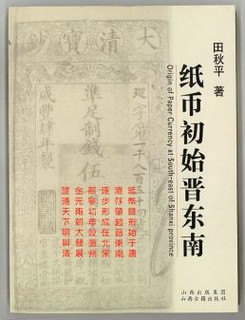
In her Chinese Money Matters blog, Helen Wang, Curator of East Asian Money at The British Museum discussed a new book on the origin of currency in Shanxi Province. -Editor
 Many thanks
to TIAN Qiuping 田秋平 for giving us a copy of his book. Many thanks
to TIAN Qiuping 田秋平 for giving us a copy of his book.
TIAN Qiuping, Zhibi chushi Jin dongnan (Shanxi guji chubanshe, 2007). ISBN 978-7-80597-856-6 // Origin of Paper Currency at South-east of Shanxi Province. TIAN Qiuping, Origin of Paper Currency at
South-east of Shanxi Province (Taiyuan: Shanxi guji chubanshe, 2007). Black and white illustrations.
Brief Table of contents
Chapter 1: Tang dynasty paper money
- The concept of "paper money" in Tang times (p.3)
- The beginnings of paper money (4)
- "Flying cash" – the start of paper money (9)
- Tang dynasty money written in ink (10)
- "Great Tang TreasureCertificates" – did they exist? (14)
Chapter 2: Northern Song dynasty paper money
- The concept of paper money in the Song dynasty (19)
- Official notes (jiaozi) (20)
- The establishment of the Luzhou jiaozi office (22)
- The suspension and end of the Luzhou jiaozi office (28)
- On the printing plates for Luzhou jiaozi (29) The meaning of qian si cang (33)
- Materials relating to Luzhou jiaozi (34)
Chapter 3: Jin and Yuan dynasty paper money
- The concept of paper money in the Jin dynasty (42)
- The "Luzhou contract" notes of the Zhenyou period (43)
- Zhenyou period printing plates unearthed in Qin xian (45)
- Jin dynasty silver ingots of Licheng county (50)
- A hundred years of Yuan dynasty paper money (51)
Chapter 4: Ming dynasty paper money
- The concept of paper money in the Ming dynasty (57)
- A Chongzhen plate for Ming dynasty notes unearthed in Luzhou (59)
- The emergence of private coin-shops (qianzhuang) (66)
- The Ming dynasty notes from Luzhou and Cangu Temple (69)
Chapter 5: Qing dynasty paper money
- The concept of paper money in the Qing dynasty (77)
- The Changzhi "coin-table" (qianzhuo) (79)
- Changzhi "coin-businesses" (qianhang) in the early Qing dynasty (81)
- Tracing back to the source of "coin-notes" (qianpiao) (93)
- The proliferation of private notes (97)
- County-level notice aimed at the qianhang (104)
- Varieties of private notes and coin-notes (112)
Chapter 6: Lu[zhou] salt and salt notes
- Traces of salt-trading in ancient times (139)
- The circulation of salt notes (yanchao, yanyin) in historical times (142)
- Bi Xiang, who issued salt notes (yanchao) and Luzhou (146
) - Some big salt traders of Luzhou (148)
- Conclusion (155)
References and sources (156)
Afterword (157)
To read the complete article, see:
65. BOOK: ORIGIN OF PAPER CURRENCY IN SOUTH-EAST SHANXI
(https://chinesemoneymatters.wordpress.com/2020/01/26/66-book-origin-of-paper-currency-in-south-east-shanxi/)
Wayne Homren, Editor
The Numismatic Bibliomania Society is a non-profit organization
promoting numismatic literature. See our web site at coinbooks.org.
To submit items for publication in The E-Sylum, write to the Editor
at this address: whomren@gmail.com
To subscribe go to: https://my.binhost.com/lists/listinfo/esylum
Copyright © 1998 - 2024 The Numismatic Bibliomania Society (NBS)
All Rights Reserved.
NBS Home Page
Contact the NBS webmaster
| 

